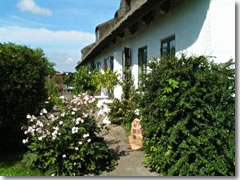Agriturisms in Denmark
Danish farm stays from TK

Cottage Farm B&B—country charm just 10 minutes from the airport and 15 from Copenhagen (www.cottagefarm.dk; ![]() ). In Denmark, bondegårdsferie (farm holidays) can range from the expected—TK; Fæbrogård, an apartment sleeping four in a 18th century thatched barn near the beach for $115 (www.faebrogaard.dk)—to the surprising.
). In Denmark, bondegårdsferie (farm holidays) can range from the expected—TK; Fæbrogård, an apartment sleeping four in a 18th century thatched barn near the beach for $115 (www.faebrogaard.dk)—to the surprising.
For example, the Cottage Farm B&B in Dragør—all thatched-roof quaintness on the outside, Danish modern and free WiFi within—is just three miles from Copenhagen International, but you'd never know you were that close to an airport or the city (from $100; www.cottagefarm.dk; ![]() )
)
How to find Danish farm stays
Many local tourist offices have lists of local farm stays.
Sadly, few are listed in English-language guidebooks—but there are often agriturismo guides available in local bookshops—in Danish, perhaps, but the important bits are easy enough: addresses, prices, and phone numbers, photographs, and icons for private baths, swimming pools, etc.
You can always just look for signs on country roads, pointing down rutted dirt tracks toward a farmhouse set among the fields.
If you want to find and book a few before you leave, here are the best online resources for finding farm stays all across Denmark. Not all sites are available in English, but the pertinent details are usually pretty easy to figure out:
Online resources
Bondegårdsferie.dk (www.bondegaardsferie.dk) - More than 100 farmhouse holidays, B&Bs, and farm visits across Denmark.
Eco-Holiday (www.ecoholiday.dk) - Network of a dozen organic bed and breakfasts in Denmark.
Become a farmhand; sleep for free - If you really want to get your hands dirty, sign up to become a temporary farmhand through one of two volunteer organizations: WWOOF (www.wwoof.org) and Helpx (www.helpx.net)... ![]()
The concept behind agritourism (or farm stays, or guest ranches, or farmhouse B&Bs, or rural tourism, or whatever you want to call it) is simple: you spend the night as a guest on a working farm. From there, though, the concept flies off in many directions.
Sometimes you just hole up for the night in a B&B converted from a farmhouse.
Sometimes you actually stick around to do volunteer work for a few days (a week, two months, a year), as with the worldwide WWOOF network.
Sometimes, just renting a cottage in a rural area where sheep wander past your window is enough to count.
Ideally, the property's owners live on-site and are farmers who derive the bulk of their income from agriculture, using this newfangled form of tourism merely to help make ends meet.
In some countries, the practice of agritourism is highly regulated; in others, it’s a wild west of opportunities, and you have to pick carefully to avoid spending the night in a barn atop a pile of hay (unless that's what you want—I've done it, and it's great).
Double rooms at a farm stay operation run anywhere from [$7 to $200], but usually around [$40 to $90.]
B&B: kr350 pp
Meal: kr165
Apt: kr600/day; kr2,500/week
I've stayed at loads of agriturisms: vineyards and dairy farms, barns amid olive groves and frescoed villas next to horse stables.
Each stay has offered me a different experience of farm life for a fraction the cost of a hotel.
Many agriturisms require a two- or three-night minimum stay (for some, a week).
Roughly half accept credit cards.
Sometimes you get four-star luxury and satellite TV. Sometimes you’re a straw's-width from sleeping in a stall.
Most, though, are just what you'd expect from a farmhouse B&B: simple comforts, solid country furnishings, and rural tranquility—barnyard noises excepted.
The hosts tend to be a sight friendlier than your average hotel desk clerk. Some invite guests to dine with them, family-style, in the farmhouse. One shepherd let me stir a bubbling pot of sheep's milk to help it on its way to becoming pecorino cheese. Vineyard owners love to crack open bottles of their best to guide you through the finer points of wine tasting.
Related Articles
|
|
This article was by Reid Bramblett and last updated in December 2011.
All information was accurate at the time.
Copyright © 1998–2013 by Reid Bramblett. Author: Reid Bramblett.
